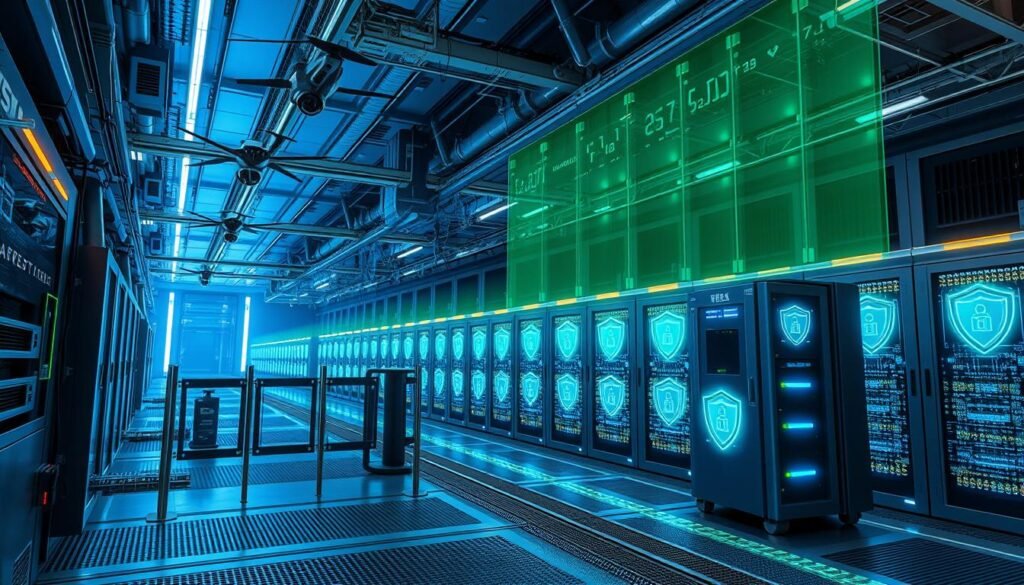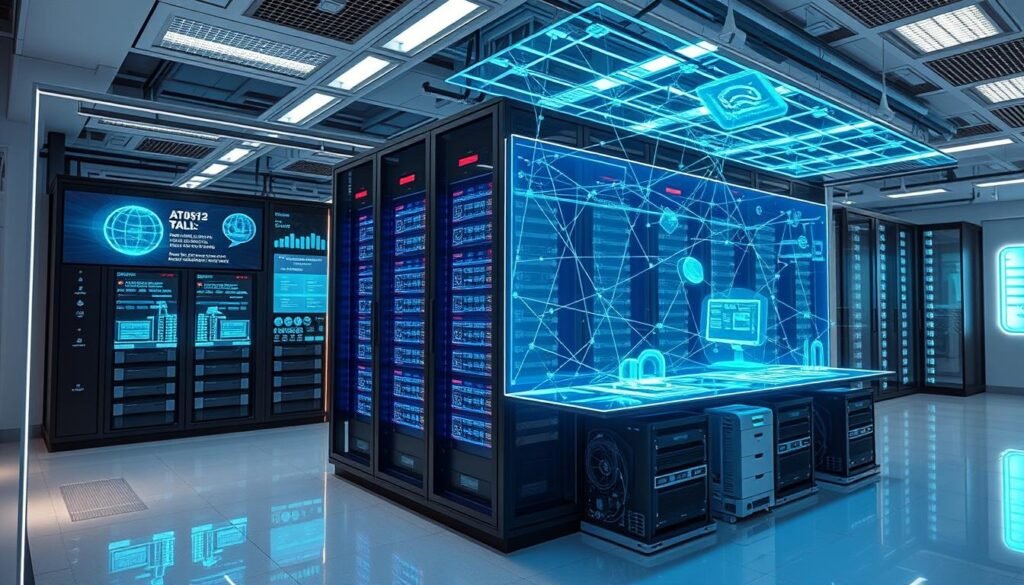By 2028, we’ll see an incredible 400 zettabytes of data. Edge computing investments will hit $378 billion. This growth is turning data centers into smart, dynamic systems that run our digital lives.
In 2025, data centers will be at a key point. Here, new tech meets huge computing needs. Cloud, big data, and edge computing are changing how we handle information.
New trends are making data centers more green, efficient, and smart. AI tools and renewable energy are leading a big change. This change will change what digital infrastructure looks like.
Key Takeaways
- Exponential data growth driving massive infrastructure investments
- Sustainability becoming a core focus for data center operations
- AI and machine learning revolutionizing data center management
- Edge computing expanding to support real-time applications
- Hybrid cloud strategies gaining prominence across industries
The Evolution of AI in Modern Data Center Infrastructure
Artificial Intelligence is changing data center infrastructure. It’s how companies handle data and cloud management. AI brings new ways to use resources better and work more efficiently.
Companies are quickly using AI to solve big data center problems. The way we use computers is changing fast. AI is playing a big part in this change.
Impact of AI on Power Requirements and Computing Demands
Data centers are changing how they use power and computers. Here are some key points:
- Now, data centers can handle servers that use over 20 kW per rack.
- 57 percent of data center owners trust AI for making decisions.
- Google cut cooling costs by 40 percent with AI.
“AI is not just a technology upgrade; it’s a fundamental reimagining of data center infrastructure.” – Industry Expert
Integration of AI-Driven Workload Management
AI is key for managing workloads better. Now, companies can:
- Automate simple tasks
- Keep track of resources in real-time
- Make systems more efficient
On-Premises AI Deployment Trends
| Deployment Strategy | Benefits | Cost Implications |
|---|---|---|
| On-Premises AI | More control over security | Costs more upfront |
| Hybrid AI Infrastructure | Scalable and flexible | Costs less over time |
| Cloud-Based AI | Deploys quickly | Lower initial costs |
The future of data centers is smart and flexible. They will adapt to changing needs. By using AI, companies can work better and faster.
Sustainable Data Center Operations and Energy Efficiency
The global data center industry is changing fast. Data centers use about 1% of the world’s electricity. This makes green data centers more important than ever.
“Sustainability is not just an environmental responsibility, but a strategic business imperative for modern data infrastructure.” – Tech Innovation Research
Energy efficiency is now a big focus in data centers. This is thanks to new strategies:
- Using renewable energy sources
- Advanced cooling technologies
- AI-driven resource management
- Optimizing power distribution systems
Big companies are working hard to cut their carbon footprint. For example, Google and Microsoft want to use 100% renewable energy by 2025. AI has also helped a lot, like Google’s Deepmind, which cut cooling costs by 40%.
Some big changes in sustainable data center energy efficiency include:
- Smart grid integration for better electricity use
- Modular designs to reduce waste
- Quantum computing for better efficiency
- Hydrogen fuel cells for clean power
By 2025, data centers will handle 175+ zettabytes of data. They will also use new green technologies to reduce their environmental impact.
Edge Computing and Distributed Architecture Revolution
The digital world is changing fast thanks to edge computing. This technology is making data management better across many fields.
Edge computing moves computing power closer to where data is. Soon, nearly 46 billion IoT devices will use it. This is key for businesses wanting quick insights.
Benefits of Edge Data Processing
Edge data management has big benefits for companies today:
- Less delay in data handling
- Better decision-making on the spot
- More secure and private data
- Less strain on network bandwidth
5G Integration and Network Expansion
Edge computing and 5G networks are opening new doors for cloud services. Fast, reliable connections are making operations more efficient.
Real-Time Processing Capabilities
Edge computing is changing how we analyze data right away. Intelligent edge machines are making big impacts in:
- Autonomous vehicles
- Healthcare diagnostics
- Manufacturing automation
- Retail customer experiences
“Edge computing is not just a technology trend, it’s a fundamental shift in how we process and utilize data.” – Technology Innovation Experts
| Industry | Edge Computing Impact | Projected Growth |
|---|---|---|
| Automotive | Real-time Vehicle Monitoring | 35% by 2028 |
| Healthcare | Remote Patient Diagnostics | 42% by 2027 |
| Manufacturing | Predictive Maintenance | 48% by 2029 |
By 2025, edge computing will hit $15.7 billion. It’s key for the future of digital tech. Your company can keep up by using these edge computing solutions.
Advanced Cooling Technologies and Thermal Management
The world of data centers is changing fast, thanks to new cooling technologies. As cloud systems get more complex, keeping them cool is key. The liquid cooling market is expected to grow a lot, from $5.1 billion in 2024 to $21.73 billion by 2031.
“Cooling is no longer just about temperature control—it’s about intelligent, sustainable energy management.” – Data Center Innovation Expert
Now, your data storage systems need advanced cooling that’s more than just air. New tech is changing how we handle heat and energy:
- Immersion cooling technologies
- Direct-to-chip liquid cooling
- AI-driven thermal management systems
- Two-phase cooling techniques
Big tech companies are taking big steps. Microsoft, Meta, and Google aim to be water-positive by 2030. Equinix has already used direct-to-chip cooling in over 100 data centers.
| Cooling Technology | Energy Efficiency | Implementation Complexity |
|---|---|---|
| Air Cooling | Low | Low |
| Liquid Cooling | High | Medium |
| Immersion Cooling | Very High | High |
The future of cooling data centers is about smart, flexible systems. These systems don’t just cool down—they also boost performance, sustainability, and efficiency.
Data Centers, Cloud Computing, Edge Computing, Big Data, Data Analytics
The digital world is changing fast. Companies must update their data plans to stay ahead. Big data and cloud strategies are key for staying competitive and efficient.
Infrastructure Optimization Strategies
Your data center’s success depends on smart planning. New tech like software-defined solutions is changing how we use resources. By 2025, 65% of tech buyers will choose as-a-service data centers.
- Use virtualization to use resources better
- Try software-defined infrastructure (SDI) for quick setup
- Improve storage setups on DAS, NAS, and SAN
Workload Distribution Models
Smartly distributing workloads is essential for top performance. Modern security for data centers uses advanced models. These models balance workloads across cloud, edge, and on-premises setups.
“The future of data centers lies in flexible, adaptive infrastructure that can dynamically allocate resources.” – Technology Innovation Experts
Performance Metrics and Analysis
Measuring data center success needs detailed metrics. Edge computing is changing the game. It’s expected to handle up to 80% of IoT data by 2025.
| Metric | 2025 Projection |
|---|---|
| Edge Data Center Market Size | $13.5 Billion |
| Global Edge Computing Market | $15.7 Billion |
| Operational Edge Data Centers | Over 6,000 Worldwide |
By using these advanced methods, your company can build a strong, adaptable data setup. This setup is ready for tomorrow’s digital world.
Security and Cyber Resilience in Data Center Operations

Keeping your digital world safe is more important than ever. Cyber threats are getting smarter, so we need strong defenses for our cloud services.
“In the digital age, security is not an option – it’s a necessity.” – Cybersecurity Expert
Companies are using new ways to protect their data and keep things running smoothly. Some of these methods include:
- AI-powered threat detection systems
- Multi-layered authentication protocols
- Real-time monitoring and incident response
- Comprehensive data privacy frameworks
With cyber threats getting more complex, we must act fast. 67% of IT pros say edge devices are more vulnerable. So, we’re focusing on smart monitoring and quick action.
New rules on data privacy are changing how we handle digital stuff. Companies are focusing on:
- Encrypting sensitive info
- Strict access controls
- Keeping staff up to date on security
- Checking for vulnerabilities often
The future of data centers is about building strong, flexible security systems. These systems should be able to spot and stop cyber threats before they happen.
Innovation in Data Center Hardware and Infrastructure
The world of data centers is changing fast. This is because we need more power and efficiency. New technologies are making big changes in how we store data and use cloud services.
New technologies are changing data centers in amazing ways. Hyperscale data centers are making computing bigger and better. They offer more power and speed than ever before.
Next-Generation Server Technologies
Modern servers are getting a big upgrade. Graphics Processing Units (GPUs) are key, with hundreds of cores for better performance. The big changes include:
- Advanced multi-core processor designs
- High-density computational modules
- Energy-efficient chip architectures
Power Distribution Updates
Managing power is now key in data centers. New solutions focus on:
- Intelligent power distribution systems
- Real-time energy consumption monitoring
- Renewable energy integration
“The future of data centers lies in intelligent, sustainable, and hyper-efficient infrastructure.” – Tech Innovation Report
Storage Solutions Advancement
Storage tech is growing fast. We now have high-density systems with lots of space and reliability. New ideas like DNA storage could change how we keep data safe, using tiny biological structures.
By 2026, the global data center market is expected to hit $251 billion. This shows the huge promise of these new technologies.
Virtual Twin Technology and Digital Modeling
Digital twin technology is changing how we manage data centers. It creates detailed virtual copies of real infrastructure. These models are so accurate, they help improve performance, cut energy use, and make operations more efficient.

The demand for digital twin technology is growing fast. It’s expected to hit $48.2 billion by 2026. This shows how important virtual modeling is for cloud computing and big data analytics.
“Digital twins are not just representations, but living models that breathe with real-time data and insights.” – Tech Innovation Experts
- Simulate computer workloads and energy consumption
- Predict heat generation and cooling requirements
- Optimize server and cooling system performance
- Reduce energy consumption by up to 10%
Companies using digital twin technology see big benefits:
| Performance Metric | Improvement |
|---|---|
| Energy Consumption | 10% Reduction |
| Cooling System Efficiency | 30% Optimization |
| Operational Insights | 90% Data Accuracy |
By 2025, 500 million digital twins will be in use worldwide. They’re changing data center management with smart, predictive models. These virtual models let us monitor, simulate, and optimize complex systems in real-time.
Workforce Development and Automation Trends
The world of data center management is changing fast. Automation and new technologies are leading the way. As cloud computing gets better, workers need to learn new skills and face new challenges.
“Automation is not about replacing humans, but empowering them to focus on high-value strategic work,” says industry experts.
Companies are seeing big changes in what they need from their teams. In 2025, we’ll see:
- More focus on training workers for new tech roles
- More jobs for people who know AI and machine learning
- More emphasis on workers who can do many things in data centers
Automation brings us important lessons:
| Trend | Impact | Workforce Adaptation |
|---|---|---|
| Infrastructure as Code | Less chance for human mistakes | Skills in programming and automation |
| AI-Driven Maintenance | Smart system management | Skills in advanced analysis |
| Edge Computing | Processing data in many places | Knowledge of distributed systems |
The future asks for constant learning. Workers need to stay flexible, learning new tech and skills that work with automation. By 2025, companies plan to spend 63% more on AI and machine learning. This shows how important it is to change the way we work.
Your success in the changing data center world depends on your ability to adapt, learn, and use the latest tech well.
Regulatory Compliance and Industry Standards
The world of data centers is changing fast. Rules are getting more complex and important for success. It’s key to understand these rules to keep data safe and green.
Companies face a complex web of rules that affect their data centers. They need to pay close attention to these areas:
Environmental Regulations
Green data centers are now a must. The push for sustainability is leading to big investments. Companies should focus on:
- Lowering carbon emissions
- Using energy-saving tech
- Meeting sustainability goals
Data Privacy Requirements
Keeping data safe is more important than ever. Key privacy rules include:
- GDPR for Europe
- CCPA for California
- HIPAA for healthcare
“Compliance is not just about avoiding penalties, but building trust with customers and stakeholders.”
Operational Certifications
| Certification | Primary Focus | Key Requirements |
|---|---|---|
| ISO 27001 | Information Security | Systematic data protection framework |
| SOC 2 | Service Organization Controls | Robust data handling practices |
| FedRAMP | Federal Cloud Security | Standardized security assessment |
By tackling these rules early, data centers can turn compliance into a strength. This ensures data is safe and operations are green.
Conclusion
Exploring the future of data centers shows how technology is changing cloud computing and data center management. Edge computing and AI are opening new doors for businesses to improve their digital setup. With 75 billion IoT devices by 2025, companies must get ready for more complex tech worlds.
Data center strategies need to consider performance, sustainability, and security. Edge computing helps save up to 80% on bandwidth and cuts decision time by 90%. Cloud analytics and edge tech together make data processing better and more efficient for today’s digital needs.
Managing data centers now means thinking ahead. With 40% of data processed at the edge soon, how we handle computing will change. By using new tech and staying flexible, businesses can lead the digital shift and gain an edge.
The future asks for constant learning and flexibility. As IoT grows and tech advances, knowing and using advanced data center tech is key. Stay up-to-date, stay quick to change, and get ready for the fast-paced world of cloud and distributed computing.



